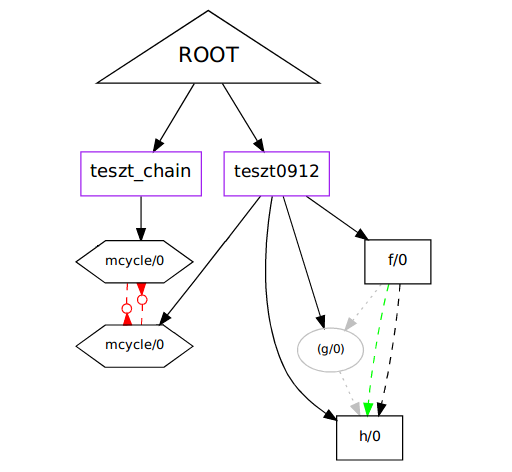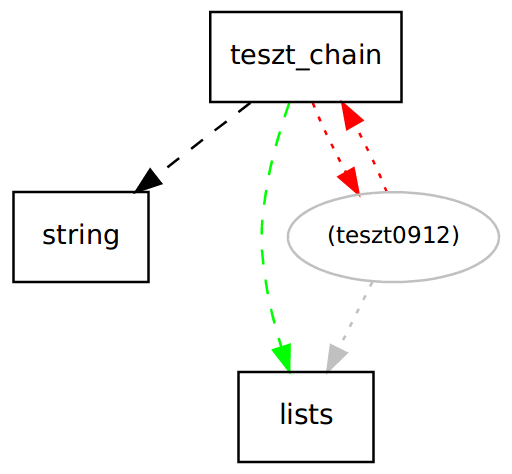| Version 8 (modified by tothm, 11 years ago) (diff) |
|---|
Dependency analysis
Concerning terminology
We say that module A depends on module B (B -> A) if there is at least one function call from B to A. There is a cyclic dependency if B also depends directly (A -> B) or indirectly (e.g. A -> C -> B) on A.
Dependency can be defined on the function level as well. Function A:foo depends on function B:foo (B:foo -> A:foo) if B:foo calls A:foo. There is a cyclic dependency if B:foo also depends on A:foo, directly or indirectly.
Note that it is possible to have a cyclic dependency among modules while having no cyclic dependencies among their functions. For example, function calls from A:foo to B:foo and from B:foo2 to A:foo2 imply a cyclic dependency on the module level, but no one on the function level.
It is also possible to have dependencies between moduleblock. A moduleblock is a list containing modules ([A, B, ...]). Moduleblock X depends on moduleblock Y (Y -> X) if any of the modules of X depends on at least one of Y's modules. In the same way as before, a cyclic dependency can be defined as well.
Capabilities
Mainly, you can check for cycles and dependencies among entities within the RefactorErl? database. This means that the program looks for dependencies on the given level, and returns with a graph representation containing those dependencies.
In case of vast databases, dependencies can be very complex, and hard to represent. To avoid producing useless, huge dependency graphs, we provide some filter options that you can use for narrowing down the result.
Filtering options
- Level - The result will only contain the dependencies based on the given level (function, module or moduleblock dependencies).
- Type - The result will contain all dependencies or only cyclic dependencies.
- Exclude - Entities depending on the exclude entities (directly or indirectly) and the exclude entities themselves are excluded from the result.
- Exclude_children - Entities depending on the exclude_children entities (directly or indirectly) are excluded from the result, but not the "exclude_children" entities.
- Exclude_lib - Entities residing in the exclude_lib libraries (but not subdirectories) are excluded from the result.
- Exclude_otp - The result will or will not contain the Erlang/OTP standard modules and functions.
- Starting_nodes - The result will only contain the starting_nodes entities and entities depending on them (directly or indirectly).
- Connection - The result will only contain the connection entities and the dependencies between the connection entities.
- Groups - Defines the moduleblocks, on which the dependency analysis will be made.
Output
The output of the dependency analysis is a graph representation, where entities are nodes and dependencies are edges between these nodes (A -> B dependency would result as a directed edge from A node to B node). This representation can be text based (as erlang terms) or visual (described in a .dot graph file).
In the text based representation entities are enumerated with entities depending on them. An entity is described as its name or the corresponding id in the database, depending entities are put in a list.
Visual representation
Function level
Function dependency graphs look like the following.
- ROOT triangle represents a formal starting point
- Rectangle, deep purple nodes represent modules
- Rectangle, black nodes represent functions given in the connection option
- Hexagon, black nodes represent functions
- Ellipse, grey nodes represent functions which are part of an indirect dependency path
- Solid, continuous edge, black, normal arrowhead to modules from the root, and the from modules to their functions
- Dashed edge, black, normal arrowhead indicates that a function calls another function
- Dotted edge, grey, normal arrowhead indicates that a function calls another function and the edge is part of an indirect dependency path
- Dashed edge, red, special arrowhead indicates a function call, but also that it is a cyclic edge
- Dotted edge, red, normal arrowhead indicates a cyclic edge which is part of an indirect dependency path
- Dashed edge, green, normal arrowhead indicates an idirect dependency
Module level
Module dependency graphs look like the following.
- Rectangle, deep purple nodes represent modules
- Rectangle, black nodes represent modules given in the connection option
- Ellipse, grey nodes represent modules which are part of an indirect dependency path
- Dashed edge, black, normal arrowhead indicates that a module calls another module
- Dotted edge, red, normal arrowhead indicates a call loop which is part of an indirect dependency path
- Dashed edge, red, special arrowhead indicates a call loop
- Dotted edge, grey, normal arrowhead indicates that a module calls another module and the edge is part of an indirect dependency path
- Dashed edge, green, normal arrowhead indicates an idirect dependency
Moduleblock level
Moduleblock dependency graphs look like the following.
- Hexagon, black nodes represent moduleblocks
- Rectangle table lists the modules of the moduleblocks
- Dashed edge, black, normal arrowhead indicates that a moduleblock calls another moduleblock
- Dashed edge, red, special arrowhead indicates a call loop
Usage
Dependency analysis can be done via the following interfaces:
Attachments (3)
- function_graph.png (28.0 KB) - added by tothm 11 years ago.
- mb_graph.png (12.6 KB) - added by tothm 11 years ago.
- module_graph.png (20.7 KB) - added by tothm 11 years ago.
Download all attachments as: .zip



